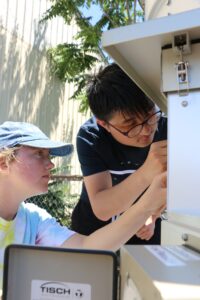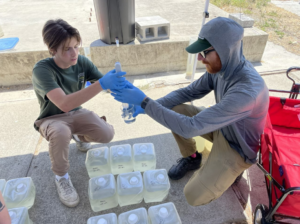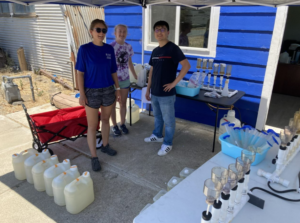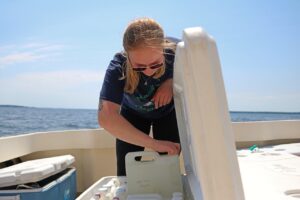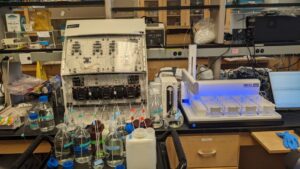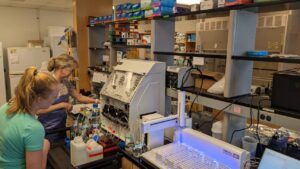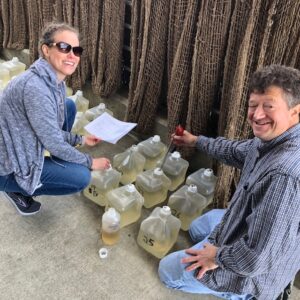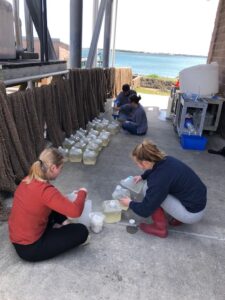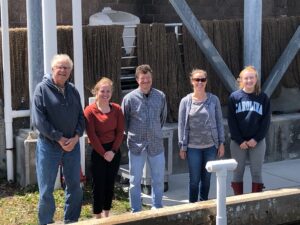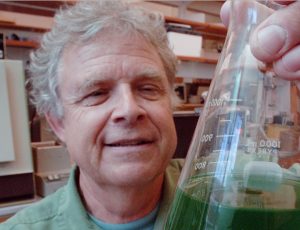The Paerl Lab was in the Bay Delta, California last week to kick off Haley Plaas’ PhD thesis research, which focuses on assessing the linkage between nutrient enrichment, phytoplankton community composition, cyanobacterial harmful algal bloom toxin production, and aerosol formation in the Sacramento-San Joaquin River/Bay Delta estuarine ecosystem. Research Technician, Leah Nelson, accompanied Haley to California where they met up with Seyong, who is one of the Paerl Lab’s summer interns. The bioassay went off without a hitch! We saw surface scums of cyanos at both of our sample locations, Discovery Bay and Stockton. Upon filtering toward the end of the week it appeared as if the P and N+P treatments responded the most, suggesting P limitation at both sites. Early aerosol findings showed Microcystis and other cyanobacterial cells collected from the air. The data will tell us soon, so stay tuned! We want to thank our collaborators at CA-DWR, USGS, and Restore the Delta (and more)!
Category: News (Page 1 of 6)
Over the past week, members of the Paerl Lab were busy at Lake Erie in Put-In-Bay, Ohio as part of a research project called the Lake Erie Center for the Great Lakes and Human Health Project supported by the National Institutes of Health (NIH) and the National Science Foundation (NSF).
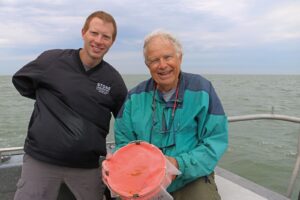
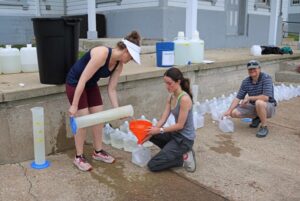
The Paerl Lab partners with Justin Chaffin of the F. T. Stone Laboratory Ohio Sea Grant School of Environment and Natural Resources at Ohio State University as well as Chris Ward who is a professor at Bowling Green State University, and his students. Hans Paerl, Karen Rossignol and Randy Sloup were accompanied by Madison Sholes, our Scientific Communication Intern, to collect samples and conduct a bioassay. While at Lake Erie, Hans also gave a talk about eutrophication to students and faculty at the Stone Lab. We are excited to go back to Lake Erie in August to conduct another bioassay for this project! Thank you to all of our scientific collaborators which make this research possible!
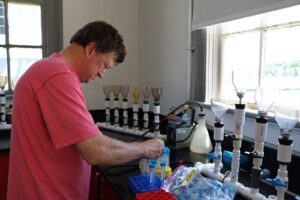
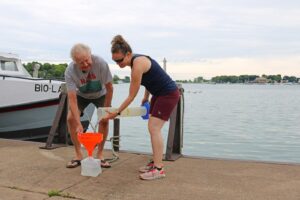
Last week, Jeremy, Alex, and Madison conducted biweekly water quality monitoring on the Neuse River! Jeremy is using a Multiparameter Water Quality Sonde to collect data on the water at each station. This instrument records information such as salinity, pH, temperature and in-situ Chl a concentrations. Alex is collecting water samples for filtering and further analysis back at the lab.
Photos by our Science Communication Intern, Madison Sholes!
The Paerl Lab installed and received training on a new SEAL Analytical QuAAtro39 Continuous Segmented Flow Analyzer last week. The QuAAtro is a wet-chemistry analyzer that is used to automate complex chemical reactions. QuAAtro uses the principle of air-segmented continuous-flow analysis where samples are mixed with reagents in a continuously flowing stream. This instrument has four manifolds that can be run at once, allowing for the concentration of Nitrate, Ammonium, Phosphate, and Silicate in a sample to be determined simultaneously. This new method of nutrient analysis will provide ultra-low detection limits and exceptional reproducibility, while also allowing for faster analysis. We are excited to put our new QuAAtro to use!
Pictures taken during training:
The Paerl Lab is conducting a bioassay in collaboration with the Zhao Research Group at NC A&T
It is suspected that dissolved organic nitrogen inputs from land-based waste sources, such as landfills and waste-water treatment plants, may be linked to the recent proliferation of harmful algal bloom forming taxa in North Carolina riverine and estuarine waters, such as the Neuse River. Therefore, this project aims to examine what potential roles dissolved organic nitrogen sources found in landfill leachate could play in algal development and proliferation by conducting in situ nutrient manipulation bioassays.
To read more about this project click here.
Paerl Lab members setting up the bioassay:
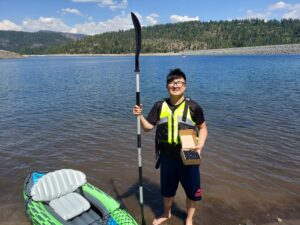
The Paerl Lab welcomes Seyong as one of our summer interns. Seyong is based in California and will be assisting with PhD student Haley Plaas’ research, which will focus on assessing the linkage between nutrient enrichment, phytoplankton community composition, cyanobacterial harmful algal bloom toxin production, and aerosol formation in the Sacramento-San Joaquin River/Bay Delta estuarine ecosystem. Welcome Seyong!

Alex is the Paerl Lab’s newest Research Technician. Alex has a Master’s degree in Earth and Environmental Science and has previous experience working with Harmful Algal Blooms. We are so excited to welcome her to the Paerl Lab!
This past week, some members of the Paerl lab traveled up to Put-In-Bay, Ohio on Lake Erie to conduct groundbreaking bioassays and aerosol investigations! Graduate students, Malcolm Barnard and Haley Plaas, were busy during the week and look forward to sharing their results soon! BIG thank you to scientists from the University of Toledo, University of Tennessee, the Ohio State University, and Bowling Green State University for their assistance during the course of the week! Check out the photos below for science being enriching and fun!
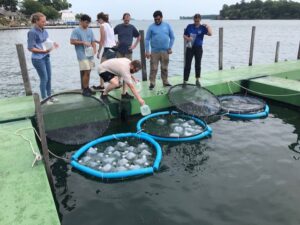
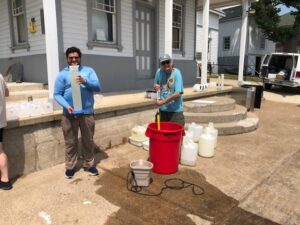

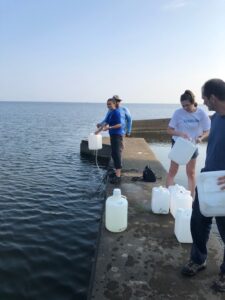
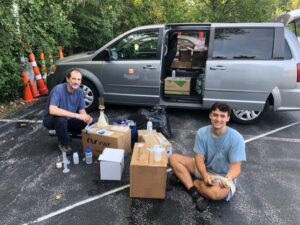

Last Friday, the Paerl Lab gathered together to carve some pumpkins and taste some yummy fall foods such as smoked pecans, apple cake, apple cider donuts, and candy corn!




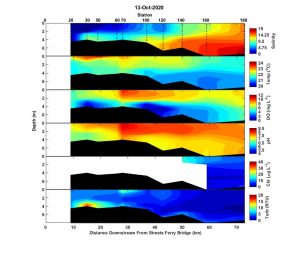
Hi all,
Our crew was out Tuesday, 13 October 2020. The estuary was stratified with pockets of hypoxic water observed near New Bern at station 30 and near the bend at stations 100 and 120. The fluorescence probe that measures chl-a failed mid-cast at station 140 and all chl-a data upstream of 140 was removed due to meaningless, negative values. A bloom at station 70, however, was indicated by the high near surface DO, observation of brown water color, and clogging of filters back in the lab. The crew observed fish actively dying south of Fairfield Harbor (our station 70) and fish dead on the surface from there to mid-channel north of Slocum Cr. (our station 100). The dominant species in the bloom, the dinoflagellate Gyrodinium instriatum aka Levanderina fissa) is not known to be toxic. G. instriatum is the most common bloom former in the Neuse during the summer and early fall and hasn’t previously been associated with a fish kill. This fish kill appears to have been ongoing since 30 September.
Best,
Nathan
